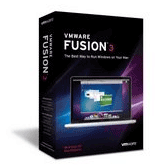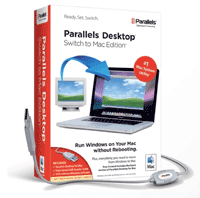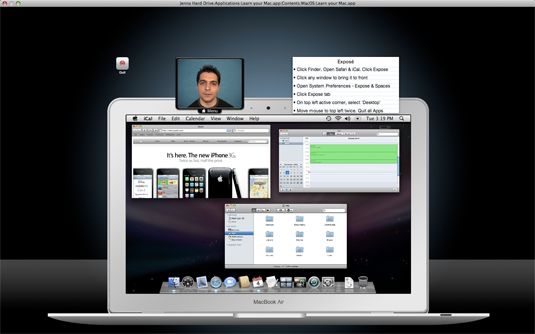 For more than two years now, my primary computing platform has been Apple’s OS X with a virtualized copy of Windows XP and/or Vista running inside it. I started running the first program that could virtualize Windows on a Mac, Parallels Desktop, the moment it became available as a beta. And mostly, I’ve stuck with Parallels.
For more than two years now, my primary computing platform has been Apple’s OS X with a virtualized copy of Windows XP and/or Vista running inside it. I started running the first program that could virtualize Windows on a Mac, Parallels Desktop, the moment it became available as a beta. And mostly, I’ve stuck with Parallels.
But Parallels’ archrival, VMware Fusion, is now shipping in version 2.0, after a few months of public beta. I’ve been using it for a few days and enjoying it. A few major features of the new version:
–The ability to do multiple snapshots of the state of a virtual machine, and to have Fusion create them automatically at set intervals, so you can jump backwards if something goes wrong;
–Keyboard mapping so you can simulate Windows keypresses that don’t exist on a Mac;
–Better handling of file associations so Windows apps can open Mac documents and vice versa;
–mirroring of folders so that Windows’ My Pictures shows stuff stored in OS X’s equivalent, for instance;
–Support for DirectX 9.0 Shader Model 2 3D graphics, making Fusion a more plausible platform for gaming and other heavy-duty 3D apps (the previous version and Parallels only go up to DirectX 8.1; Parallels also supports OpenGL);
–A year of free McAfee Viruscan Plus security (Parallels comes with six months of Kaspersky’s suite);
–Support for multiple monitors;
–General polish and fit and finish improvements to make the app as Mac-like as possible.
I wanna live with Fusion for a while before I make any attempt to declare a winner in the Mac virtualization race; both it and Parallels are pretty darn good, and the competition between them has unquestionably resulted in two strong products. There’s no doubt, however, that VMware tried to catch up with Parallels or surpass it in a number of places where the latter product was in the lead until now.
Virtualization still can’t replace running a native operating system in every case. Both Fusion and Parallels exact a stiff tax in the form of reduced battery life on my MacBook Pro, I find. And there are still apps that run poorly, or not at all. (As an experiment, I just tried to run Real’s RealDVD, thinking that the DVD-ripping functionality would be a good stress test–but it wouldn’t even install in Fusion.) So I also use Leopard’s Boot Camp feature to turn my MacBook Pro into a true, non-virtual PC…and I have a Vista desktop, too.
Oh yeah–what do I run within virtualized Windows? Office 2007, for one thing–I like it much more than the Mac’s Office 2008. And Internet Explorer 8. And Chrome. And other applications as I need ’em–it’s a blessing to be able to run nearly any Windows application without leaving OS X, as any virtualization fan can attest.
VMware Fusion is $80, but it’s a free upgrade for current users. You need a copy of Windows XP or Vista to use it (or another of the 90 operating systems it supports, including Linux and OS X Leopard Server). More thoughts once I’ve spent more time with it…

 Was it really only a little over three years ago that the formerly fanciful notion of being able to run Windows apps within OS X without major limitations
Was it really only a little over three years ago that the formerly fanciful notion of being able to run Windows apps within OS X without major limitations  Parallels Desktop was the first software that let you virtualize Windows on an Intel Mac (and is current archrival of
Parallels Desktop was the first software that let you virtualize Windows on an Intel Mac (and is current archrival of 
 Lotsa cool-techology news today…
Lotsa cool-techology news today… Parallels Desktop for Mac was the first software product that let you run virtualized copies of Windows within OS X on a Mac. It was a feat which created the closest thing in existence to an ideal computing platform, as far as I’m concerned. But Parallels ended up in fierce competition with VMWare’s Fusion, and version 2.0 of Fusion was the
Parallels Desktop for Mac was the first software product that let you run virtualized copies of Windows within OS X on a Mac. It was a feat which created the closest thing in existence to an ideal computing platform, as far as I’m concerned. But Parallels ended up in fierce competition with VMWare’s Fusion, and version 2.0 of Fusion was the  For more than two years now, my primary computing platform has been Apple’s OS X with a virtualized copy of Windows XP and/or Vista running inside it. I started running the first program that could virtualize Windows on a Mac,
For more than two years now, my primary computing platform has been Apple’s OS X with a virtualized copy of Windows XP and/or Vista running inside it. I started running the first program that could virtualize Windows on a Mac,